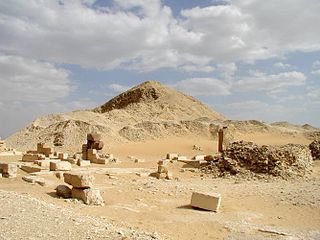| Khuit in hieroglyphs | ||||||
|---|---|---|---|---|---|---|
xwit | ||||||
Khuit II was a wife of King Teti, the first pharaoh of the Sixth Dynasty of Egypt. [1]
| Khuit in hieroglyphs | ||||||
|---|---|---|---|---|---|---|
xwit | ||||||
Khuit II was a wife of King Teti, the first pharaoh of the Sixth Dynasty of Egypt. [1]
Khuit may have been the first prominent royal wife from the reign of Teti. If so, her position would later be taken over by Iput. Khuit may have been the mother of King Userkare (according to Jánosi and Callender), [2] but this is not at all certain and some would have a queen named Khentkaus IV as the mother of Userkare. [3] Khuit was a mother of Tetiankhkem, whilst Khuit's daughter could be Seshseshet Sheshit. [4]
According to her monuments Khuit held the titles:

The pyramids of Iput I and Khuit were discovered between July 1897 and February 1899 by Victor Loret just north of Teti's pyramid complex at Saqqara. [6]
Loret initially thought Khuit's tomb was a mastaba. Excavations in the 1960s by Maragioglio and Rinaldi first suggested that Khuit had been buried in a pyramid. Remains of masonry belonging to the ruins of a small mortuary temple were found as well. Further excavations in 1995 by Hawass have confirmed that Khuit's tomb was a pyramid. Excavations of the pyramid itself revealed a burial chamber with a pink granite sarcophagus. The mortuary temple associated with her funerary complex is located to the east of the pyramid. The temple included an offering room with a false door and an altar. The temple walls were decorated and showed scenes of offering bearers. [2]
Teti, less commonly known as Othoes, sometimes also Tata, Atat, or Athath in outdated sources, was the first king of the Sixth Dynasty of Egypt. He was buried at Saqqara. The exact length of his reign has been destroyed on the Turin King List but is believed to have been about 12 years.

The Sixth Dynasty of ancient Egypt, along with the Third, Fourth and Fifth Dynasty, constitutes the Old Kingdom of Dynastic Egypt.
Iput I was a queen of ancient Egypt, a daughter of King Unas, the last king of the Fifth Dynasty of Egypt. She married Teti, the first Pharaoh of the Sixth Dynasty of Egypt. Their son was Pepi I Meryre. She possibly ruled as regent for her son Pepi I.

Ankhesenpepi II or Ankhesenmeryre II was a queen consort during the Sixth Dynasty of Egypt. She was the wife of Kings Pepi I and Merenre Nemtyemsaf I, and the mother of Pepi II. She likely served as regent during the minority of her son. She was buried in a pyramid in Saqqara.

Ahmose-Henuttamehu was a princess and queen of the late 17th-early 18th dynasties of Egypt.
Sesheshet, occasionally known as Sesh, was the mother of King Teti, the first and founding pharaoh of the Sixth Dynasty of Ancient Egypt. She was instrumental in enabling her son to gain the throne and reconciling two warring factions of the royal family.
Iput was an ancient Egyptian queen consort of the Sixth Dynasty, a sister and wife of Pepi II.

Ankhesenpepi IV was an ancient Egyptian queen, a wife of Pharaoh Pepi II of the Sixth Dynasty. She was the mother of a crown prince Neferkare. Pepi II also had several other wives.
Udjebten or Wedjebten was an ancient Egyptian queen consort, a wife of Pharaoh Pepi II of the Sixth Dynasty.
Nubwenet was an ancient Egyptian queen consort, a wife of Pharaoh Pepi I of the 6th dynasty.
Inenek, also called Inti, was an ancient Egyptian queen consort, a wife of Pharaoh Pepi I of the 6th Dynasty.

Isetnofret was a royal woman of Ancient Egypt and, as the Great Royal Wife of Pharaoh Merenptah, she became Isetnofret II.

Takahatenamun was a Nubian queen dated to the Twenty-fifth Dynasty of Egypt.
Khensa (Khenensaiuw) was a Nubian queen dated to the Twenty-fifth Dynasty of Egypt.

Naparaye was a Nubian queen dated to the Twenty-fifth Dynasty of Egypt.
Persenet was an ancient Egyptian queen consort of the 4th Dynasty. She may have been a daughter of Pharaoh Khufu and a wife of Pharaoh Khafre. She is mainly known from her tomb at Giza.
Reptynub was a queen during the Fifth Dynasty of Egypt. She was the wife of King Nyuserre Ini. She was possibly a mother of Menkauhor Kaiu.
Khenut was the queen consort of Egypt as the wife of King Unas. She lived during the time of the Fifth Dynasty of Egypt. She was a suspected mother of Queen Iput.
Tem was an ancient Egyptian queen consort of the 11th Dynasty, a wife of Pharaoh Mentuhotep II and the mother of Mentuhotep III. She was buried in Tomb DBXI.15 in Deir el-Bahari, in her husband's mortuary complex. She outlived her husband and was buried during her son's reign. It is likely that she was of commoner origin, as there is no evidence in her grave that points to a royal origin. She is only named on her sarcophagus and on an offering table. Her titles are "King's beloved wife" (ḥmt-nỉswt mrỉỉ.t=f), King's Mother" (mwt-nỉswt), Mother of the King of Upper and Lower Egypt (mwt-nỉswt-bỉt), and Great of Sceptre (wr.t-ḥt=s).

Sadeh or Sadhe was an ancient Egyptian queen consort, a lower ranking wife of Pharaoh Mentuhotep II of the 11th Dynasty. Her tomb (DBXI.7) and small decorated chapel were found in her husband's Deir el-Bahari temple complex, behind the main building, along with the tombs of five other women, Ashayet, Henhenet, Kawit, Kemsit and Mayet. She and three other women of the six bore queenly titles, and most of them were priestesses of Hathor, so it is possible that they were buried there as part of the goddess's cult, but it is also possible that they were the daughters of nobles the king wanted to keep an eye upon.